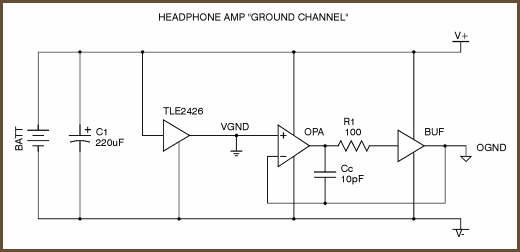OK, a couple of points.
Although there are a number of '3 channel' or 'ground channel' designs on show on the web, the general consensus in the wider engineering community is that these don't actually perform as well as designs using a more conventional ground arrangement such as using the junction between two 9V batteries for the ground. Some test data on this subject is available, but I can't link to it because the member has been banned. Take a look at the O2 amplifier thread though...
This is not the whole story, because some sources insist that a 'virtual ground' or rail splitter design runs less risk of damaging headphones due to a DC offset at the output should one battery go flat while the other still has output, but given that there is measurable degradation supported by a theoretical rationale it seems a contradiction to me to spend a lot of money on opamps only to employ them in a dubious configuration.
There are other ways of building an amplifier to ensure that a DC offset does not damage headphones although they all add complexity to the design and reduce battery life. If, however, you feel confident that you can monitor the battery situation yourself (some distortion would almost certainly become audible before damage to the headphones occurred) and are not likely to fall asleep while using the amplifier, then this protection can be omitted entirely.
A number of searches on my part have failed to disclose
anybody complaining that their headphones were destroyed by the failure of one battery out of two.
That said, I
do think the additional opamp in your diagram is overkill.
The Grado RA-1 portable headphone amp uses a single NJM4556 opamp. This is a cheap device. Less than a dollar US, although they can be awkward to obtain at the lowest prices particularly as demand for hobby quantities has been high recently due to the O2, which uses 2. I understand your desire to have the very best, cost no object, and the AD797 is undoubtedly a very fine opamp, but all components need to be matched to their intended use and its output @ 50mA is less than the 70mA (times 2) of the NJM4556. Whether the other performance differences between the 2 devices are audible, as opposed to measurable, is open to question. I doubt very much that it is, but others will insist that they can hear one. Grado certainly choose to use the NJM4556 in a $400 product, which would seem to allow sufficient profit margin to permit the use of any opamp under the sun.
The principal advantages of a dual as opposed to a single are cost and convenience. Where 2 devices are being paralleled there is the additional factor that devices on the same die are well matched, which lends itself to paralleling. Crosstalk between duals as opposed to singles may be worse, but still exceeds the known threshold of audibility by a considerable degree.
Another device you could look at is is the TLE2062, which has a very low quiescent current. Although the distortion is higher, it is still probably below the threshold of audibility. Again, using a dual per channel would be recommended, just because it is nice to know you are not running a device close to its limits. Most amplifiers' distortion goes up with output.
The main disadvantage to the NE5532s I mentioned earlier is the 10mA quiescent current which eats into the battery life a bit.
A simple protection circuit:-

As shown with 8.4V NiMh PP3 batteries, when the total battery voltage drops by > ~5V the relay will drop out. The cost is 10mA. The relay will tolerate considerable excess voltage so regular alkalines can be used. With the 11V zener the relay should pull in as long as the batteries are not close to discharged. It will drop out and will not pull in if one battery is flat or disconnected. The relay is good for 2A.
w




